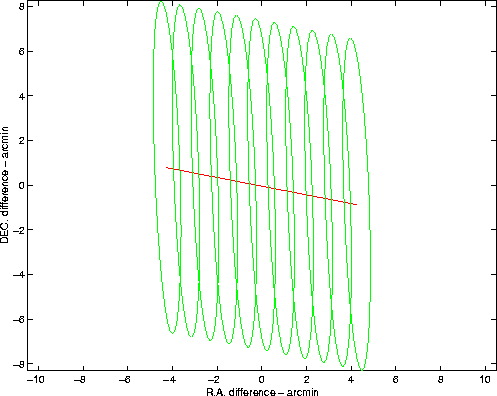 |
The different orbital histories for the 2014 VI on one hand, and the 2038, 2044 and 2046 VIs on the other, lead to different observing opportunities. Given that this object is faint, the main constraint is that observations are possible only when the geocentric distance is small, e.g., less than 0.5 AU, the best opportunities corresponding to the closest approaches. For the 2014 VI there is an observing opportunity during a very close approach in January 2001. For the 2038, 2044 and 2046 VIs there are observing opportunities during a shallow encounter in February 2001, and even better ones during the January 2003 close approach. We shall discuss all three of these opportunities. Detailed ephemerides for each opportunity described below are available at http://copernico.dm.unipi.it/neohome/virimp
The 2014 VI in January 2001
This VI approaches the Earth in the third week of January 2001. The encounter takes place after passage of the asteroid from perihelion: the object is too close to the Sun to be observed before the encounter, and in just one day moves from the evening sky into the opposition region where it will rapidly slow down during the following days. On January 24 it will already move only one degree per day being around magnitude 14.5 V; then it will fade 0.3-0.5 magnitudes per day until the end of the month. The observing conditions on January 24 are given in Table 2, and the size and location of the region of the sky to be searched are shown in Figure 2. The region to scan is the envelope of the ellipses, and measures about 9 arcmin in right ascension and 16arcmin in declination, thus the VI is easy to find, if it exists.
The 2038, 2044 and 2046 VIs in February 2001
The three VIs happen to be all visible at about magnitude 20.5, close to opposition, in the second part of February 2001 (see Table 3, which has been computed for February 23), although observations can start one month earlier and stop one month after that date. They will be close to the celestial equator and stay far from the Milky Way. The three VIs are less than a degree apart from each other, and the envelopes of their projected uncertainty regions are about 16 arcmin or less in right ascension and 12 arcmin or less in declination; one example of the skyprint is shown in Figure 3. Few telescope frames should be necessary to exclude them all; however, the telescopes to be used need to have rather faint limiting magnitudes.
The 2038, 2044 and 2046 VIs in February 2003
All three VIs are in favorable conditions for observation after an Earth encounter taking place in January, much like the 2001 opportunity for the 2014 VI (see Table 4 and Figure 4, all referred to February 3). At this time the three VIs are comparatively bright (about magnitude 17.5), but the proper motion has already slowed down to an almost main-belt rate. Their projected uncertainties are larger than in the previous cases, up to 1 degree for the 2046 VI, and the three regions to be searched for the three VIs are a few degrees apart. Therefore, it will be necessary to take more frames, but this is compensated for by the much brighter magnitude at which the search has to be conducted, allowing the use of comparatively small telescopes.
 |
| Epoch: 2001 Jan. 24.0 UT | |
| Impact Year | 2014 |
| Right Ascension | 8:42:12.1 |
| region | |
| motion (deg/day) | 0.817 |
| Declination |
|
| region | |
| motion (deg/day) | -0.371 |
| V mag | 14.2 |
| Solar Elongation |
|
| Galactic latitude |
|
| Solar Distance (AU) | 1.0108 |
| Earth Distance (AU) | 0.0272 |
| Epoch: 2001 Feb. 23.0 UT | |||
| Impact Year | 2038 | 2044 | 2046 |
| Right Ascension | 11:06:27.8 | 11:05:11.8 | 11:03:59.3 |
| region | |||
| motion (deg/day) | -0.652 | -0.650 | -0.649 |
| Declination |
|
|
|
| region | |||
| motion (deg/day) | 0.230 | 0.230 | 0.231 |
| V mag | 20.5 | 20.5 | 20.5 |
| Solar Elongation |
|
|
|
| Galactic latitude |
|
|
|
| Solar Distance (AU) | 1.3451 | 1.3438 | 1.3425 |
| Earth Distance (AU) | 0.3699 | 0.3681 | 0.3665 |
| Epoch: 2001 Feb. 3.0 UT | |||
| Impact Year | 2038 | 2044 | 2046 |
| Right Ascension | 8:35:21.0 | 8:20:07.6 | 8:05:22.4 |
| region | |||
| motion (deg/day) | 0.280 | 0.587 | 0.906 |
| Declination |
|
|
|
| region | |||
| motion (deg/day) | -0.068 | -0.136 | -0.200 |
| V mag | 17.1 | 17.1 | 17.2 |
| Solar Elongation |
|
|
|
| Galactic latitude |
|
|
|
| Solar Distance (AU) | 1.0827 | 1.0800 | 1.0774 |
| Earth Distance (AU) | 0.0992 | 0.0971 | 0.0954 |